A few hopefully helpful things to know when cruising Fiji…
1. WAYPOINTS ARE KEY. There are reefs all over Fiji and around entrances to many anchorages. The existing charts are old, out-of-date, and often wrong (by as much as a mile or more). Good waypoints into the anchorages and for certain routes around reefs are very helpful. As usual in the tropics, there are areas where you need to watch for bombies so someone on the bow keeping a lookout is helpful as even the best waypoints can put you close to reefs and the lurking bombies. (That said, we found Fiji reefs much easier to negotiate than, say, the Tuamotus! The only entrance that challenged us was into the lagoon at Fulaga.)
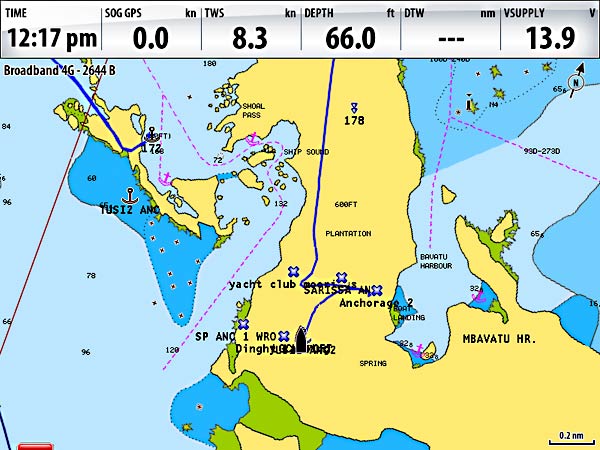
The best source we found for waypoints is the compendium put together by the cruisers on Soggy Paws. We used those waypoints extensively and they were always spot on. They also have a “files” section in their compendium with all sorts of downloadable guides and info at svsoggypaws.com/files/. (One that came in handy was the pdf file: “Mr. John” in Fiji.) Come to find out, they also have “A Mariners Guide to Fiji.” This is the book the marinas will give you when you check into the country, and it’s got a lot of helpful stuff.
Another source for waypoints is Curly, an expat who lives in Savusavu and gives weekly seminars to new arrivals on how to cruise Fiji. He gives out a packet of maps with some waypoints at his seminar. He emails you another list of waypoints after the seminar. He gives you a lot of useful waypoints and if you don’t find what you need, he gives out his e-mail address so you can check to see if he has the waypoints you need. Update: Curly has passed on, but maybe someone else has taken over for him.
And of course there’s other cruisers. We’ve found cruising Fiji needs to be a bit of a group exercise, finding out about places from those who’ve gone ahead of you, and sharing your discoveries with those behind you.
I will mention here a guide available online called “A Yachtsman’s Fiji.” It’s a bit out of date but still helpful. Here’s a link.
2. GOOGLE EARTH CHARTS. We used charts made from Google Earth a lot in Fiji and we really love them. This satellite imagery has to be the way of the future for navigation. We use OpenCPN, running on our PC, to display them. There are two ways to get them: download them from a friend or from Soggy Paws – they have a really nice collection for Fiji, or make them yourself – it’s easy.
Here’s a link to the charts on Soggy Paws website. Thank you Soggy Paws – you guys are the best! We so appreciate all you do for the us and the cruising community in general. And another shout-out to Google for making this possible.
To make our own charts, we used a readily-available program: GE2KAP. Here’s a link to Soggy Paws discussion of making GE charts.
Whether you download the GE charts or make your own, I would just add one thing: make sure, after you’ve told openCPN where to look for the charts (wrench icon/charts tab), you also check the check boxes for “Scan Charts and Update Database” and “Force Full Database Rebuild.” Don’t worry if both options aren’t available to check. Then hit the “Apply” button and the charts will show up.
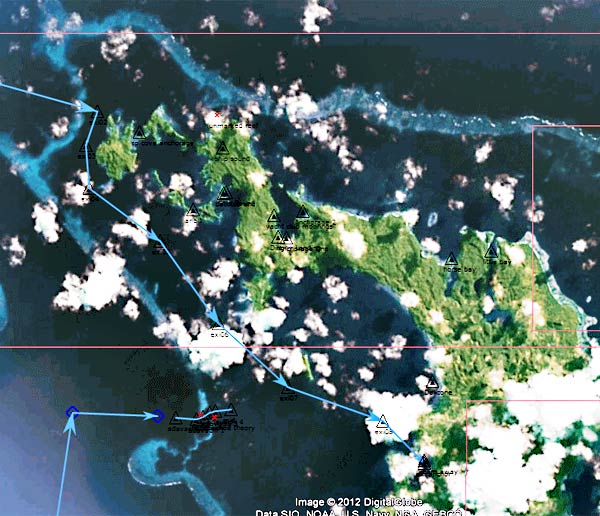
You can see from the chart above that they’re not perfect. For Fiji, sometimes it’s hard to find images without clouds over the very spot you want to anchor, or the pass you need to slip through. Still, sometimes it’s better than any other charts.
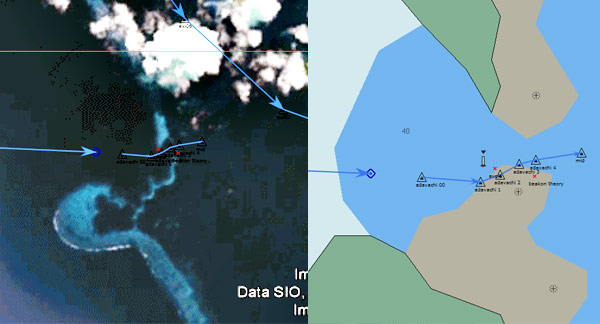
The Google Earth chart above lets you see exactly where the reef is. We used these extensively for planning. It made us feel good to see that our waypoints went around versus over the reefs on the Google Earth images.
Note: Another source of Raster Charts: We found that NZ has some very good, free charts of the Pacific. We haven’t tried them in Fiji yet but I think they’re well worth downloading. They are located here. We downloaded both the “Latest Annual file” as well as the “Latest Cumulative Update.” Copy the files in the update to the folder with the annual file, replacing any duplicates. They can be viewed in openCPN (remember to update database as above).
3. WINDS. I don’t like to be the bearer of inconvenient news, but the winds are an issue here. This means that you can’t just move about to fit a schedule. When the winds kick up, it can get a little wild in these shallow, reef-strewn waters. Twenty knots might not mean much on the open ocean, but it can kick up some big seas here and needs to be taken seriously. When trying to go against the conditions, nature humbled us very quickly.
One thing Curly stated is that most people who end up on reefs do so because they are trying to keep a schedule (more specifically trying to get someone to the airport). We have seen a pass that’s a total pussycat in calm weather develop into a tiger with teeth when the wind picks up. The difference was pretty amazing.
Weather windows in which you can move your boat come about once every week or so (although sometimes longer). Weather windows to go east are less frequent as you are basically looking for very light or no-wind conditions that you can motor through. Some people manage to sail east, but I can’t imagine how. We wait for very light conditions, turn on the engine, and leave early in the morning.
Bottom line: you don’t pick your weather windows, they pick you.
4. SEVUSEVU CEREMONIES. A sevusevu ceremony is a Fijian ritual practiced in the villages, and its purpose is to accept someone new into the village. If you want to stay in certain anchorages in Fiji, you will probably need to take part in a sevusevu as the anchorage is considered part of the nearby village. And you will need to come prepared with the two required items:
Kava. Also called yaqona (pronounced “yangona”). You will need to present between 1/3 and 1/2 kilo of fresh kava root, depending on the importance of the village. Picture a knob of ginger, only about 2 feet or 3 feet long and shaped a bit like a stretched-out carrot. (Better yet, check Google images.) When I say fresh, I mean not processed. Curly will tell you that you need keep kava fairly fresh by buying new batches if yours get old, but we found the kava we bought in mid-June lasted all season. (I will say the last of it, given away at the end of October, looked a little tired, but we made up for it by giving more, and our Fijian friend seemed quite happy with it.) You can buy the kava at central markets in towns and cities already wrapped in newspaper and ribbon as is customary. It’s easiest just to stock up wherever you check in before you head out cruising, and then replenish the supplies as you go if need be. Curly recommends starting with about 3 kilos, and I think this is about what we had.
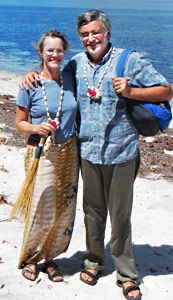
A Sulu. This is a long sarong you tie around your waist like a skirt, and it covers your legs. This is mandatory for women, but in our experience, a sulu isn’t necessary for men for sevusevus. Men might want to get one anyway as you may end up going to a village church and you’ll feel more appropriate in one. Sulus can be purchased in towns and cities and you can pick one up where you check in.
Men: you need to at least wear long pants for the sevusevu as it’s impolite to have your knees exposed.
Because you will have researched any given anchorage before you go, you’ll pretty much know when you need to do a sevusevu ceremony. So, let’s say you’ve decided to go to an anchorage where a sevusevu is required. The process goes like this:
1. Enter the area and set your anchor. Decide how much kava you’re going to give. If you’re female, make sure to bring along your sulu. I hear you’re supposed to keep your shoulders covered, but I’m not sure this is necessary. When in doubt, you might want to wear a T-shirt instead of a tank top.
Hop in your dinghy and head on in, and put your sulu on as soon as you get the dinghy beached. Tradition states that, once in the village, you ask for the Turaga ni koro (too-ranga nee koro), a village headman who will hear your intentions then present you and your kava to the chief (and your fee if you’re in the Lau).
In our experience, you don’t need to look for anyone: they see you coming, and they are waiting for you. If no one is on the beach, start walking to the village and tell the first person you see that you need to present your sevusevu. They will help you. Curly made this whole thing sound very intimidating, but the Fijians enjoy visitors. As long as you’re respectful and have kava, you will be welcomed.
2. After you have your Taraga ni koro person, he will take you to the chief’s hut and have you wait while they get ready. He will guide you through the process. You may have a few people there, or it may be just you and the taraga ne koro and the chief. Remove your shoes before you go in, and remove any hats or sunglasses. By the way, when you walk through a village, remove and carry your backpack in your hand (I don’t know why this is traditional, but it is). You will then be asked to sit on the floor on mats. Men sit cross-legged, and women sit with their legs bent and to the side. The chief will sit in front of you.
The Taraga ni koro will ask you questions like: Where are you from? Do you have children? What do you hope to see in our village? He’ll use this information in presenting you to the chief.
3. The Taraga ni koro will present you and your kava to the chief, who after some chatting between the two of them, will clap 3 times. There will then be a speech in Fijian and you will sit and listen respectfully even though you don’t understand a thing. There will then be chanting and more clapping, and eventually you will be told by your taraga ni koro that your gift has been accepted and you are welcomed into the village.
4. Now, small talk ensues. The chiefs generally do not speak English, but the taraga ni koro will interpret. They will ask you about yourselves, and maybe you want to ask them some questions if you can think of any. You can ask to take pictures. You can compliment the beauty of their village. And when conversation lags, the meeting will end and you will be able to head back to your boat. You may be given a gift of fresh papaya from one of their trees as the taraga ni koro escorts you to the path back to your dinghy.
We never took part in a kava ceremony (which is supposedly part of the sevusevu) and in our experience the sevusevus did not include drinking kava (fine with us!).
As far as the number of sevusevus you need to do, peoples’ experiences differ dramatically! I can sum it up like this. Imagine a scale of people, and on one end of the scale are the extroverts and the people who love to immerse themselves in a culture. On the other end of the scale are the introverts and the anti-social party poopers who’d rather be doing their own thing. Rich and I are towards the latter end of the scale. We don’t relish doing sevusevus, experiencing village life, struggling to make conversation when we don’t speak the language, or having a bunch of people piling onto our boat. We kept our sevusevus to an absolute minimum and in our entire six months of cruising eastern Fiji, only took part in only three ceremonies, two of which were in the Lau group, and one of which (in Makogai – the giant clam place) was with more of a park ranger than a chief.
Other people, however, did lots of sevusevus, many in anchorages where they weren’t all that necessary. We found one constant with the Fijian people: they love their kava! If you go ashore with visible kava root, asking to do a sevusevu, you can always find people happy to make that happen. Much like if someone came to my house wanting to share a bottle of Dom Perignon for the honor of parking on my street, I’d officially welcome them and rush to get the glasses.
When you seek out sevusevu, you just might find yourself taking part in an actual kava ceremony. We’d heard stories of parties that went on late into the night, but it seems this seemed to happen mostly with guys? The only time Rich and I had kava was at the Leleuvia resort buffet.
I will mention that Rich and I were definitely in the minority in that most people seemed to get a big kick out of the sevusevu process and taking part in village activities. I think the few of us who don’t share this enthusiasm mostly keep our mouths shut. Really, there is no right or wrong here. If you’re not into it, you can keep it to a bare minimum. If you love it, knock yourself out! (Be prepared to have visitors on your boat–you can’t have too many cookies!)
To immerse yourselves in village life or do your own thing? Whichever you choose, we’d suggest that you make sure you’re on the same page with your partner. This seemed to be a source of the occasional rift.
5. GIFTS. As any cruiser knows, it’s good to come prepared with gifts. You won’t need them all the time, but there are times when they’re nice to have on hand. If you go to a village, especially in the Lau, you’ll probably end up going to at least one home for a meal, and you’ll want to bring at least one present.
Things we found to be much appreciated in Fiji are nail polish, reading glasses, cookware, machetes, flour, sugar, breakfast crackers (you’ll find these in any supermarket), cookies (!), tea, goodies for kids, etc.
One thing to keep in mind is you will almost definitely be invited to a Lovo (Fijian feast) on the beach, and there will be kids. One person gave out inflated plastic beach balls, letting the kids keep them, and someone else had an inflatable raft. If you go to the village at Kioa, you will probably visit the school, so school supplies might be appreciated.
Imagine living without medical and dental care. One gift we always gave out was something called triple antibiotic cream, available in local drug stores in the towns. Painkillers need to be approached with caution as they can be dangerous if misused. I’m thinking next time we go, we’ll buy a bottle of local Tylenol, aspirin, Advil or what have you, with instructions in Fijian, so we can give them away with a clear conscience. And it did occur to me that something like Ambesol, a gum-numbing medication, would be a wonderful thing here. I intend to look for it in New Zealand.
Oh, and one more thing: animal lovers might want to have some dog biscuits on hand. Mostly, the animals are cared for here, but all dogs appreciate a treat (cats, too).
So, use your imagination. Pretend you live in a hut and are cooking and living with minimal supplies. What would you like someone to bring you? Oh, not alcohol. Village chiefs to do not appreciate that.
6. BUG REPELLENTS. Of course you know you need insect repellent, but we want to mention the plug-in things we found in the grocery stores in Fiji. They work surprisingly well. I don’t remember what they’re called, but you basically plug them into an outlet and let them do their work. The best ones we found had a bottle of “bug juice” you screwed into the plug-in base. They are 220 volts but worked great on our 110 volt boat.
You might also try mosquito coils in the evening. And take it from me, if you get a bite and scratch it raw, use the triple antibiotic cream from the local drug stores. You might have to ask for it as it’s sometimes behind the counter. It saved me from a couple of nasty infections.
This year, we’re also going to try the sprayers that automatically emit a squirt of repellent every few minutes. They’re available in New Zealand at stores like Bunnings. We’ve been using one in NZ for a while now and it works pretty well. Friends tell us they’ve used them in Fiji and they work well there also.
Don’t worry – bugs aren’t all that bad in Fiji – at least not in our experience.
7. GUESTS. I am so torn on this one. On the one hand, what a wonderful thing to be able to do, invite someone to stay on your boat and see places in Fiji that aren’t accessible to the average tourist. On the other hand, it’s because of their inaccessibility that these places can be hazardous to travel to and from in windy weather.
Curly’s advice, and I fully agree, is don’t travel to pick up guests, have them travel to you or a nearby area where you can pick them up. If they’re unable to do that, and they are going to be with you less than a month, then I’d advise picking them up in Nadi (the international airport city where everyone arrives), and then cruise the islands of western Fiji. With the Yasawas and Mamanucas, and places like the Blue Lagoon and Manta Ray Bay, there are lots of scenic wonders to keep guests entertained.
In any case, warn guests that Fiji can get windy and it will limit travel. We saw one boater with guests who were complaining bitterly because they spent 10 days stuck in Savusavu and expected to be sailing all over the place. I felt sorry for the boat owner because his friends didn’t hide their anger and disappointment.
Another time we saw this same cruiser head out with another round of guests into weather he had no business going out in. Three hours later, they were back with their tails between their legs. It seems these guests had also been complaining, and he did his best to take them somewhere, anywhere, to make them happy. But the winds and seas did not want them to be happy. As a cruiser, you’ve probably seen how winds and seas have no respect for you, your schedule, your guests’ schedule, your guests’ expectations, anyone’s comfort, your boat, or your life. They can be so darn thoughtless, those winds and seas! Especially in Fiji.
8. DIVING AND SNORKELING! There’s some incredible diving and snorkeling in Fiji!
Update: Fiji was hit by a devastating Cyclone, Winston, in early 2016. All the reefs were affected to varying degrees, some extensively damaged and some remaining unscathed. The good news is the coral is returning, but it may take time before some sites are restored. Dive shops can probably give you information on particular sites.
The Rainbow Reef is one of Fiji’s best diving areas, well named for its colorful corals. The White Wall is particularly special but only doable for about 3 days at a time, occurring twice a month, when conditions are such that there’s enough current so the coral opens up but not so much that your next stop will be Australia. Taveuni Dive has a schedule for diving opportunities for the season,and this may affect when you want to go to Viani Bay. There are several dive operators on Taveuni who will pick you up at your boat in Viani Bay. Newly arrived is a dive resort right in Viani Bay. See our Viani Bay post.
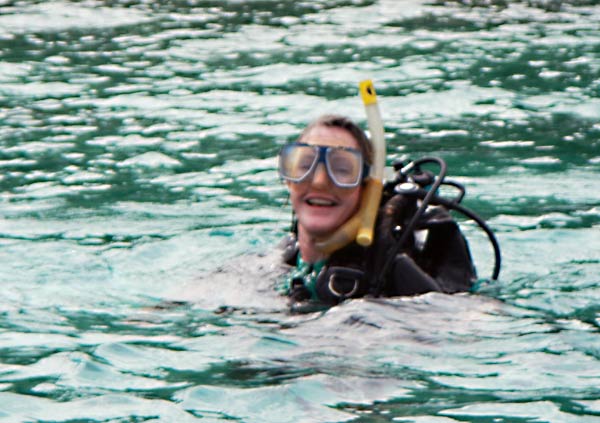
Namena Island is about 25 miles from Savusavu and is one of the top dive areas in Fiji. The island is a marine sanctuary. There used to be a small dive resort here, but sadly it was destroyed by Cyclone Winston. I assume the mooring balls off the island are gone, too. Rich and I spent three days anchored off the island and going on on dives with the resort boat. We did six dives total, and they were absolutely fantastic. If you love diving, this place is a must-do, but until they rebuild the resort (rumored to be happening and hopefully finished in 2019), it looks like going with Koro Sun Dive is the best bet.
Koro Sun Dive runs trips from the Savusavu area out to Namena and will provide transportation to their dive shop a few miles out of town, get you equipped, and take you out on their boat for two dives. We went to Grand Central Station and The Chimneys, and it was spectacular. The trip took about 2 hours each way.
(If you must, you can sign up with the Cousteau resort but we would not recommend them. We talked to their dive shop and didn’t like them at all, and we’ve heard other people have had bad experiences with them).
Our Favorite Dives in Fiji:
There is so much fantastic diving in Fiji that it’s hard to choose, but I’d have to say our favorites have been Namena Island, Rakiraki (north Viti Levu), and the Beqa shark dive. Close behind is Alacrity Rocks (Kadavu), the Rainbow Reef (off Viti Levu and Taveuni), and Beqa Island diving in general. Of course there’s other great diving, too–these are just our particular favorites.
Swimming and Snorkeling: The best places we’ve found are: Viani Bay (and the Rainbow Reef outside of it), Albert Cove, the Matei area of Taveuni island, Fulaga, the Bay of Islands area of Vanua Balavu, Namena Island, Koro Island (Dere Bay), Makogai (to see the giant clams), Leleuvia Island, and Namara Island in the Kadavu area.
All of the above all are nice for swimming and snorkeling, but the very, very best of this group for snorkeling are: the Rainbow Reef, Namena Island, Fulaga Island, Koro Island, Leleuvia Island and Namara Island. Also, there is big coral-covered rock off the Cousteau Resort anchorage that’s wonderful. (See the link to our post in the anchorage descriptions below for a waypoint).
The Anchorages:
Here are some of our videos of Fiji dives…
The Cabbage Patch
The Fish Factory
Diving the White Wall
Diving at Grand Central Station (aka the Grand Canyon), Namena Island
Diving at the Pinnacles in Namena Island (aka the Chimneys)
9. INTERNET: We found internet is pretty good in Fiji (compared to Tonga, any internet is pretty good). We didn’t find much in the way of wifi but the Copra Shed Marina was installing it when we left. We used a cellular modem or dongle… you know, the little stick you plug in to a USB port. We tried Digicel but found it wanting. Vodefone seemed to work the best for us. We’d buy 2GB blocks of data at a time. There were almost always specials like buy 2GB, get 2GB free. We tried to wait for these specials. We bought both the dongle and the data and air time at the little Vodefone booth in Savusavu. (Note: our NZ Vodefone dongle wouldn’t work in Fiji – we had to buy a new one. They weren’t expensive.)
We were really surprised at how widespread the cellular signal seemed to be. We were able to check email and post blog posts in some pretty remote bays. No luck in most of the Lau though.
- Part One: Our Fiji Saga
- Part Two: A Fiji Overview
- Part Three: Things You Need to Know to Cruise Fiji
